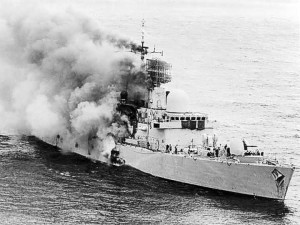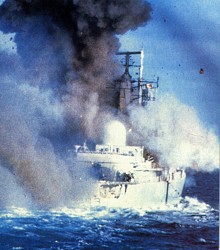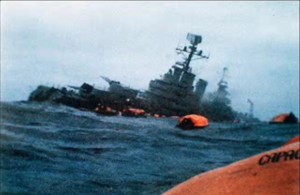We suggest here listening to Ken Coates, concerning Treaty Violation by Nuclear Weapons
In 2005 the diary of Francois Mitterand’s psychiatrist Ali Magoudi was published, who was meeting with the president twice a week during the Falklands conflict. For 7th May he records Mitterand arriving late, and exclaiming as he came in:
Excuse me, I had a difference to settle with the Iron Lady. That Thatcher, what an impossible woman! With her four nuclear submarines inthe South Atlantic, she’s threatening to unleash an atomic weapon angainst Argentina if I don’t provide her with the secret codes that will make the missiles we sold the Argentines deaf and blind.
Mitterand felt obliged to give in: ‘She’s got then now, the codes’, and his lament continued:
One cannot win against the insular syndrome of an unbridled Englishwoman. Provoke a nuclear war for a few islands inhabited by three sheep as hairy as they are freezing! But its a good job I gave way. Otherwise, I assure you, the Lady’s metallic finger would have hit the button (The Guardian 22.11.05, Sunday Times 20.11.05; Freedman Pol Studies Rev. 2007, 5, p.41)
I suggest this greatly endorses what Tam Dalyell told our Belgrano Enquiry in 2005; and what is in his book ‘Thatcher’s Torpedo’
As Paul Rogers explained to the Belgrano Enquiry: on the 4th of May, two days after the Belgrano was sunk, HMS Sheffield was hit by an air-launched Exocet missile, and was ‘within afew hours reduced to a smouldering wreck,’ which was ‘a tremendous shock to the Navy.’ A high risk was then perceived, that ‘the Argentine naval aviation would try to fire its remaining Exocets:’ had either of Britain’s two aircraft carriers Invincible or Hermes been hit, the
retaking of the Falkand islands would not have been possible that winter.
A Polaris Submarine
‘It was at that time that the decision was taken apparently to deploy a Polaris submarine within range of Argentina…It would have been in fact 3,000 miles north of the Falkland Islands’ (p105) but this would still have been well within its range – the target would have been the Argentine military complex at Cordoba (AR p.104).
Five British nuclear-powered hunter-killer submarines were deployed in the Falklands war, Paul Rogers explained: ‘five of those submarines were deployed in the Falklands area to act as forward protection to the Task Force ships, forming a barrier between the Argentine coast and the area of Task force operations.’ However, two of these had to guard the Polaris boat in the mid-Atlantic – thus, ‘for the key period of the war right up until just before the landings at San Carlos there were only three of these submarines protecting the entire task force.’ The Conqueror, which sunk the Belgrano, was one of these. But this small number was not enough, especially when one of these the HMS Splendid developed mechanical trouble. Thus, Paul Rogers explained, the job of protection could not be performed adequately by these three submarines, ‘and the Polaris submarine had precedence as far as we can tell.’
The situation was far from clear he explained, adding ‘it may be that one reasons log books have had a tendency to disappear is that they would tell us a lot more about this sequence of events.’
Nuclear Depth Charges
There was a lot of anxiety over the sinking of HMS Sheffield because it carried nuclear depth charges. Swedish ‘Stenor’ ships were employed after the war to salvage something from this ship. Some have suggested that this was just to rescue codebooks – but, the Sheffield was towed for a couple of days away from the Falklands before it sunk, and why else would they have bothered to do that? Also, it should have been possible to rescue or jettison any remaining documents on board the wrecked ship, if they still remained, during this period. It was not only the Sheffield: A ‘Seasearcher’ was trying to retrieve nuclear devices from the tomb of HMS Coventry as well. Also, nuclear depth charges were lost from two lost Sea king mark 4 and mark-5 helicopters according to Tam Dalyell (Thatcher’s Torpedo, p.33).
Treaty Violation
Did the UK violate the Treaty of Tlatelolco which it had signed and ratified (in 1969)? This declares the whole of South America to be free of nuclear weapons. An entire continent had agreed to remain free of nuclear weapons, by the terms of this treaty. The Argentine government complained that Britain had violated this Treaty, by bringing in nuclear-powered submarines into the area, and thereby sinking the Belgrano. The enforcement body which polices the Treaty of Tlatelolco questioned the British government, and it replied: HMG never answers questions about whether its ships are carrying nuclear weapons, but it has not breached its obligations under the treaty (!). (RA 101) The UK Conservative government claimed to have ‘scrupulously’ adhered to the terms of the Treaty. We note three aspects to the alleged treaty violation: use of nuclear-powered submarines (which HMG claimed were not banned by the treaty); use of tactical nuclear weapons; and use of a strategic nuclear threat ie Polaris.
The Assessor’s Report from the Enquiry concluded, ‘it appears to have been established that some of the ships, especially those which had been involved in the Mediterranean NATO exercise, Springtrain, set off with tactical nuclear weapons on board. Nuclear weapons were off-loaded and transferred to RFA Regent at Ascension island in mid-April; but, maybe not all of them (AR p.102). Recent confirmation of this has appeared – April 12th, 2010. We quote from the Daily Mail:
Some British naval ships carried nuclear weapons during the Falklands War, it has emerged. The Ministry of Defence confirmed that it did have some nuclear depth chargers, used for destroying submarines, aboard some vessels in 1982, but there was no question of using them. Nuclear weapons were transferred from ship to ship to prevent any being within a Latin American zone, in accordance with a treaty.
An MoD spokesman said: “We can confirm that we did have some nuclear depth chargers. “We did have some being carried with the Task Force and they were being transferred from ship to ship for safety reasons and to meet our obligations under the Treaty of Tlatelolco. The weapons themselves were not deployed in the course of the conflict. We said in 1982 that there was no question at all of our using nuclear weapons in this dispute. We said it was inconceivable that we would use or threaten to use nuclear weapons.”
This is an outright admission of treaty violation!
The following video ‘Malvinas/Falklands War: How close to Defeat’ describes how the task force was depached so quickly that there was no time to unload its nuclear weapons:
Note the quote, ‘whether we’d have gone as far as nuclear I don’t know, I doubt it’ (6 minutes).




“We did have some being carried with the Task Force and they were being transferred from ship to ship for safety reasons and to meet our obligations under the Treaty of Tlatelolco….
This is an outright admission of treaty violation!”
Clearly it isn’t!
Stuart – would you clarify that? The quote admits that the Task Force carried nuclear weapons into the area designated by the Treaty as being nuclear-free. Why is that not a violation?
The MOD position and what they did to resolve the nuclear weapons issues are clearly stated in “The carriage of nuclear weapons by the Task Group assembled for the Falklands campaign” available as a pdf on http://www.mod.uk/DefenceInternet/AboutDefence/CorporatePublications/BoardsOfInquiry/BoardsOfInquirybois.htm
Another document on the BOI webpages is the “HMS CONQUEROR Op CORPORATE Report of Proceedings covering the period from 6 April to 16 June 1982” also available as a series of pdf documents. It would be interesting to your readership if they were included as a link on your website.
Regards
Jon
Jon is rather over-gentle in his comments, as is Stuart. The task force left its nuclear weapons on Ascension – outside the area covered by the treaty. Your statements here are therefore specious nonsense.
BTW – Guess which country wasn’t a Tlatelco treaty signatory in 1982? Yes, that’s right – Argentina.
If FOARP is correct this article needs an omission, if Argentina wasn’t a signatory of the treaty then the treaty is hardly enforceable in Argentine waters / contested waters around Argentina.
From Wiki page on Treaty of Tlatelolco; “Argentina ratified in 1994, more than 26 years after signature, and was thus unprotected by the zone during the Falklands War.”
Britain complied with the treaty because the Falklands were part of the treaty area (note that the Malvinas, as the Argentinians are wont to call the islands, would not have been part of the nuclear weapon free zone because Argentina hadn’t ratified the treaty). By stating that the area was covered by the Treaty of Tlatelolco then Argentinians are admitting the de jure British status of the islands despite their de facto occupation of the territory.
The Task Force didn’t leave its nuclear weapons on Ascension, that is made clear in the report “The carriage of nuclear weapons by the Task Group assembled for the Falklands campaign” but this report also makes clear the reasons why (not wanting to delay the task force, lack of secure storage on Ascension and lack of secrecy at Ascension), the proscription on taking nuclear weapons into the Falklands Zone and also the fact that this instruction was complied with.
http://www.radarmalvinas.com.ar/informes/09%20armas%20nucleares%20task%20force%20traba.pdf
I would also give no trust whatsoever to a report saying that we had neutralisation codes for Exocet missiles on 7th May when on 25th May MV Atlantic Conveyor was hit by two Exocets. Bearing in mind that she held vital supplies (Heavy lift helicopters, tents, ammunition, etc, ) and was also capable of acting as a Harrier flight deck, Atlantic Conveyor was a serious loss to British Operations. If we had neutralisation codes we would have used them.
Regards,
Stephen